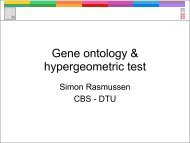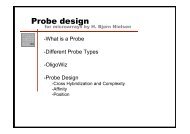Computational tools and Interoperability in Comparative ... - CBS
Computational tools and Interoperability in Comparative ... - CBS
Computational tools and Interoperability in Comparative ... - CBS
Create successful ePaper yourself
Turn your PDF publications into a flip-book with our unique Google optimized e-Paper software.
Table 2 A list of all stra<strong>in</strong>s <strong>and</strong> their accession numbers used <strong>in</strong> this comparison. Each row represents the NCBI Entrez sequenc<strong>in</strong>g project. The<br />
number of base pairs <strong>and</strong> prote<strong>in</strong> cod<strong>in</strong>g genes are those derived as the sum with<strong>in</strong> each project. C. botul<strong>in</strong>um str. F Langel<strong>and</strong> is that used as<br />
reference of the comparison<br />
Species Segments Size Prote<strong>in</strong>s<br />
C. acetobutylicum ATCC 824 14<br />
Entrez Project 77: Chromosome: AE001437,<br />
Plasmid pSOL1: AE001438<br />
4.132.880 3.848<br />
C. beijer<strong>in</strong>ckii NCIMB 8052 (unpublished) Entrez Project 12637: Chromosome: CP000721 6.000.632 5.020<br />
C. botul<strong>in</strong>um A str. ATCC 19397 (unpublished) Entrez Project 19517: Chromosome: CP000726 3.863.450 3.552<br />
C. botul<strong>in</strong>um A str. ATCC 3502 6<br />
Entrez Project 193: Chromosome: AM412317,<br />
Plasmid pBOT3502: AM412318<br />
3.903.260 3.671<br />
C. botul<strong>in</strong>um A str. Hall (unpublished) Entrez Project 19521: Chromosome: CP000727 3.760.560 3.407<br />
C. botul<strong>in</strong>um F str. (unpublished) Entrez Project 19519: Chromosome: CP000728,<br />
Plasmid pCLI: CP000729<br />
4.012.918 3.659<br />
C. difficile 630 15<br />
Entrez Project 78: Chromosome: AM180355,<br />
Plasmid pCD630: AM180356<br />
4.298.133 3.787<br />
C. kluyveri DSM 555 (unpublished) Entrez Project 19065: Chromosome: CP000673,<br />
Plasmid pCKL555A: CP000674<br />
4.023.800 3.913<br />
C. novyi NT 16<br />
Entrez Project 16820: Chromosome: CP000382 2.547.720 2.325<br />
C. perfr<strong>in</strong>gens ATCC 13124 25<br />
Entrez Project 304: Chromosome: CP000246 3.256.683 2.876<br />
C. perfr<strong>in</strong>gens SM101 17<br />
Entrez Project 12521: Chromosome: CP000312,<br />
Plasmid 1: CP000313, Plasmid 2: CP000314,<br />
Viral segment phage phiSM101: CP000315<br />
2.960.088 2.631<br />
C. perfr<strong>in</strong>gens str. 13 18<br />
Entrez Project 79: Chromosome: BA000016,<br />
Plasmid pCP13: AP003515,<br />
3.085.740 2.723<br />
C. tetani E88 19<br />
Entrez Project 81: Chromosome: AE015927,<br />
Plasmid pE88: AF528097<br />
2.873.333 2.432<br />
C. thermocellum ATCC 27405 (unpublished) Entrez Project 314: Chromosome: CP000568 3.843.301 3.191<br />
Clostridium phage 20<br />
Phage c-st: AP008983 185.683 198<br />
Web services workflow<br />
A workflow was written <strong>in</strong> Perl (v5.8.7),<br />
employ<strong>in</strong>g SOAP:Lite (v0.69) which<br />
reads the FASTA files of the database<br />
stra<strong>in</strong>s listed <strong>in</strong> Table 3 <strong>and</strong> produces a<br />
BLASTatlas us<strong>in</strong>g the C. botul<strong>in</strong>um<br />
stra<strong>in</strong> F Langel<strong>and</strong> as reference. The<br />
script uses the onl<strong>in</strong>e web service (see<br />
Fig. 4). The BLASTatlas figure produced<br />
by this workflow is seen <strong>in</strong> Fig. 5.<br />
Results<br />
Fig. 3 represents a BLASTatlas for plasmid<br />
pE88 from Clostridium tetani stra<strong>in</strong><br />
Fig. 4 Workflow description: a Perl script was written for h<strong>and</strong>l<strong>in</strong>g the assembly of the SOAP<br />
envelope <strong>and</strong> contact<strong>in</strong>g various other web services operations: (A) obta<strong>in</strong><strong>in</strong>g genomes sequence:<br />
us<strong>in</strong>g the getSeq operation of the GenomeAtlas Web Services (v.3.3), the genome sequence of the<br />
reference genome is obta<strong>in</strong>ed as one cont<strong>in</strong>uous str<strong>in</strong>g. (B) Obta<strong>in</strong><strong>in</strong>g atlas annotations:<br />
annotated CDS, rRNA, <strong>and</strong> tRNA features of the GenBank record of the reference genome<br />
us<strong>in</strong>g the getFeatures operation—these are the features which will be pr<strong>in</strong>ted <strong>in</strong> a separate lane<br />
on the atlas. (C) Obta<strong>in</strong><strong>in</strong>g ORF annotations of the reference genome: aga<strong>in</strong>, us<strong>in</strong>g the getFeatures<br />
operation, all codon sequences <strong>and</strong> their translations are obta<strong>in</strong>ed. (D) Obta<strong>in</strong> databases: read<br />
FASTA files conta<strong>in</strong><strong>in</strong>g prote<strong>in</strong>s <strong>and</strong> ORFs of the database genomes to be added as lanes. The<br />
output of A–F are assembled <strong>in</strong>to a s<strong>in</strong>gle SOAP request, <strong>in</strong>clud<strong>in</strong>g configurations of the atlas.<br />
(E) Poll<strong>in</strong>g the queue: once the job has been submitted, a 32 character hex str<strong>in</strong>g is returned for<br />
identify<strong>in</strong>g the job, which can be used by operation pollQueue to see the status of the job.<br />
(F + G) Obta<strong>in</strong><strong>in</strong>g result: once a status ‘‘FINISHED’’ is obta<strong>in</strong>ed from pollQueue, the job id<br />
can submitted to fetchResult <strong>and</strong> the result<strong>in</strong>g PostScript image is returned.<br />
E88. The homology for genes <strong>in</strong> the<br />
plasmid to other sequenced genomes is<br />
shown <strong>in</strong> the circles, additional ‘‘custom<br />
lanes’’ represent chromosomal regions<br />
predicted to open under superhelical<br />
stress. The chromosomal location of the<br />
genes encod<strong>in</strong>g colT <strong>and</strong> tetR are labelled<br />
<strong>in</strong> the figure. Notice that these two prote<strong>in</strong>s<br />
conta<strong>in</strong> regions of homology that<br />
are found <strong>in</strong> most of the Clostridium<br />
proteomes searched. S<strong>in</strong>ce the C. tetani<br />
plasmid is <strong>in</strong>cluded <strong>in</strong> the genome sequence<br />
(black circle <strong>in</strong> the figure), all<br />
the genes are found <strong>in</strong> this genome (solid<br />
black), <strong>and</strong> most of the other Clostridium<br />
proteomes conta<strong>in</strong> some weak homology<br />
but <strong>in</strong> general lack most of the plasmidencoded<br />
genes. Thus, this is a quick overview<br />
of gene conservation of a plasmid<br />
compared to many sequenced genomes of<br />
the same genera.<br />
To demonstrate this for an entire bacterial<br />
genome (which is millions of bp <strong>in</strong><br />
size, compared to a small/B75 000 bp<br />
plasmid, shown <strong>in</strong> Fig. 3), we have used<br />
the genome sequence of C. botul<strong>in</strong>um<br />
stra<strong>in</strong> F Langel<strong>and</strong>, the largest of the<br />
C. botul<strong>in</strong>um genomes, to build a prote<strong>in</strong><br />
BLASTatlas of all publicly available<br />
fully sequenced Clostridia genomes, <strong>in</strong>clud<strong>in</strong>g<br />
all chromosomes, plasmids <strong>and</strong><br />
phages (see Fig. 5). Each lane of the atlas<br />
corresponds to a sequenc<strong>in</strong>g project that<br />
conta<strong>in</strong>s the ma<strong>in</strong> chromosome plus any<br />
This journal is c The Royal Society of Chemistry 2008 Mol. BioSyst., 2008, 4, 363–371 | 367









